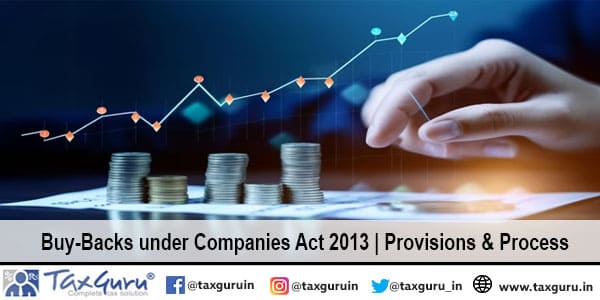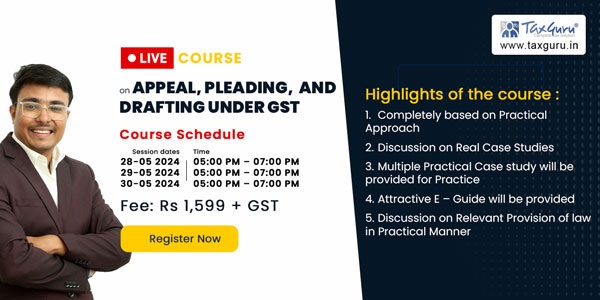Introduction:
Buy-back provisions under the Companies Act 2013 offer companies a mechanism to repurchase their own shares, providing flexibility in capital management. This article delves into the nuanced regulations governing buy-backs, including eligibility criteria, procedural requirements, and compliance obligations.
> Provisions to be read: Section-68 of the companies act,2013 read with Companies (Share capital and Debentures) Rules,2014
Page Contents
- ♦ Sources for buy-back under Companies Act 2013
- ♦ Quantum of Buy-back under Companies Act 2013
- ♦ Methods of Buy-back
- ♦ Process of Buy-back
- ♦ IMPORTANT FORMS related to Buy-Back
- ♦ Buy-Back Completion Timeline
- ♦ Buy-Back out of free reserves or securities premium account
- ♦ Restriction on Buy-Back and other Important Points
- ♦ Timeline for Buy-back
♦ Sources for buy-back under Companies Act 2013
1. Free reserves
2. Security Premium Reserves
3. Proceeds of issue of share or securities other than same kind of share or securities
♦ Quantum of Buy-back under Companies Act 2013
1. “10 % of Paid up +free reserves” (authorisation by board of directors by BR passed in Board meeting)
2. “25 % of paid up + Free reserves” of standalone or consolidated financial statements, whichever is less (authorisation by shareholders via special resolution passed in EGM/AGM)
> Debt equity ratio of company shall not be greater than 2:1 post buy-back.
> Maximum Paid up Equity Share Capital for Buy-back: 25% of its total paid up equity share capital.
- Explanatory statement required for special resolution (Rule 17(1) of Companies (share capital and Debentures) Rules,2014
a. The date of the board meeting at which the proposal for buy-back was approved by the board of directors of the company;
b. The objective of the buy-back;
c. The class of shares or other securities intended to be purchased under the buy-back;

d. the number of securities that the company proposes to buy-back;
e. the method to be adopted for the buy-back;
f. the price at which the buy-back of shares or other securities shall be made;
g. the basis of arriving at the buy-back price;
h. the maximum amount to be paid for the buy-back and the sources of funds from which the buy-back would be financed;
i. the time-limit for the completion of buy-back;
j. (i) the aggregate shareholding of the promoters and of the directors of the promoter, where the promoter is a company and of the directors and key managerial personnel as on the date of the notice convening the general meeting;
k. (ii) the aggregate number of equity shares purchased or sold by persons mentioned in sub-clause (i) during a period of twelve months preceding the date of the board meeting at which the buy-back was approved and from that date till the date of notice convening the general meeting;
(iii) the maximum and minimum price at which purchases and sales referred to in sub-clause (ii) were made along with the relevant date;
if the persons mentioned in sub-clause (i) of clause (j) intend to tender their shares for buy-back –
(i) the quantum of shares proposed to be tendered;
(ii) the details of their transactions and their holdings for the last twelve months prior to the date of the board meeting at which the buy-back was approved including information of number of shares acquired, the price and the date of acquisition;
l. a confirmation that there are no defaults subsisting in repayment of deposits, interest payment thereon, redemption of debentures or payment of interest thereon or redemption of preference shares or payment of dividend due to any shareholder, or repayment of any term loans or interest payable thereon to any financial institution or banking company;
m. a confirmation that the Board of directors have made a full enquiry into the affairs and prospects of the company and that they have formed the opinion-
(i) that immediately following the date on which the general meeting is convened there shall be no grounds on which the company could be found unable to pay its debts;
(ii) as regards its prospects for the year immediately following that date, that, having regard to their intentions with respect to the management of the company’s business during that year and to the amount and character of the financial resources which will in their view be available to the company during that year, the company shall be able to meet its liabilities as and when they fall due and shall not be rendered insolvent within a period of one year from that date; and
(iii) the directors have taken into account the liabilities (including prospective and contingent liabilities), as if the company were being wound up under the provisions of the Companies Act, 2013
n. a report addressed to the Board of directors by the company’s auditors stating that
(i) they have inquired into the company’s state of affairs;
(ii) the amount of the permissible capital payment for the securities in question is in their view properly determined;
(iii) that the audited accounts on the basis of which calculation with reference to buy back is done is not more than six months old from the date of offer document; and
♦ Methods of Buy-back
1. Existing shareholders on a proportionate basis
2. Open market
3. Esop/ESPS/Sweat equity
♦ Process of Buy-back
1. Call a Board Meeting as per to section 173 of the companies act, 2013.
2. Call EGM as per to section 100 the companies act, 2013 & pass SR and File MGT-14 to ROC in 30 days of date of passing SR.
3. File with the Registrar of Companies a letter of offer in Form: SH-8 in 30 days of Passing SR.
4. File declaration of solvency to the ROC in Form:SH-9 verified by an affidavit to guarantee its solvency for at least a year after the completion of buy-back
5. Dispatch letter of offer to the Shareholders or security holders within 20 days from the date of filing SH-8(letter of offer) with ROC.
6. The offer for buy-back should remain open for a period for a maximum period of 30 days from the date of dispatch of the letter of offer. (Provided that where all members of a company agree, the offer for buy-back may remain open for a period less than fifteen days.{100% consent})
7. The company should complete the verifications of the offers received within 15 days from the date of closure of the offer and the shares lodged shall be deemed to be accepted unless a communication of rejection is made within 21 days from the date of closure of the offer to the shareholders .
8. The company shall immediately after the date of closure of the offer, open a separate bank account and deposit therein, the total amount payable as consideration for the shares offered for buy back.
9. The company should make payment within 7 days of verification & acceptance of shares for buy-back.
10. A company after the completion of buy-back is required to extinguish and physically destroy its securities within 7 days of the last day on which the buyback process is completed
11. The company shall maintain a register of shares or other securities which have been bought-back in Form No. SH.10, it will be attached in Form SH-11
12. On completion of the buy-back process, the company shall within a period of 30 days file with the Registrar a return in the Form No. SH-11 with a certificate in Form No. SH- 15(signed by 2 directors of a company including a MD, if any)
1. SH-8:- letter of offer for buy back (TO ROC)
2. SH-9:- declaration of solvency (TO ROC)
3. SH-1O :- Register of buy-back with Description of shares or other specified securities bought back
4. SH-11 :- Return of buy-back (TO ROC)
5. SH-15:- Compliance certificate of buy-back
♦ Buy-Back Completion Timeline
Every buy-back is required to be completed within 12 months from the date of passing the Special Resolution or the Board Resolution, as the case may be.
Where a Company purchases its own shares out of free reserves or securities premium account then a sum equal to nominal value of the shares purchased has to be transferred to the Capital Redemption Reserve Account (CRR) A/c.
♦ Restriction on Buy-Back and other Important Points
- The companies are restricted to Buy-back its shares-
1. Through any subsidiary company including its own subsidiary companies
2. Through any investment company or group of investment companies
3. If company has made default in the repayment of deposits.
- Company shall complete the buy back within 12 months from the date of passing Special resolution.
- Company shall not do buy back of same kind of security for 1 year after the completion of buy-back of shares.
- A Report Addressed To The Board Of Directors By The Company’s Auditors Stating That:
a. They have inquired into the company’s state of affairs;
b. The amount of the permissible capital payment for the securities in question is in their view properly determined;
c. That the audited accounts on the basis of which calculation with reference to buy back is done is not more than six months old from the date of offer document; and
d. The Board of directors have formed the opinion that the company shall not be rendered insolvent within a period of one year from that date.
> Audited statement shall not be older than 6 months from the date of letter of offer.
♦ Timeline for Buy-back
1. 7 days: BM Notice and BR by BOD
2. 21 days: EGM notice and SR by Shareholders & MGT-14 to ROC (30 days)
3. 20 Days: letter of offer to shareholders from filing SH-8 to ROC.
4. Offer period :- 30 days (less than 15 possible if 100 % consent)
5. 7 days:- payment to shareholders whose offer has been accepted
6. 7 days: – extinguishment of share certificates.
7. 30 days: – File return of buy back to ROC.
> If the Company will give Shorter Notice for EGM and also will able to take approval from Shareholders for Opening of Letter of Offer for less than 15 days and file all the required forms to roc ASAP, then this buyback Period can be reduced to 15 to 20 days.
Conclusion:
Understanding buy-back provisions under the Companies Act 2013 is essential for companies seeking to optimize their capital structure. By adhering to eligibility criteria, procedural requirements, and compliance obligations, companies can execute buy-backs efficiently while ensuring regulatory compliance. Effective management of buy-backs facilitates capital optimization and enhances shareholder value, contributing to the overall growth and stability of the company.


























